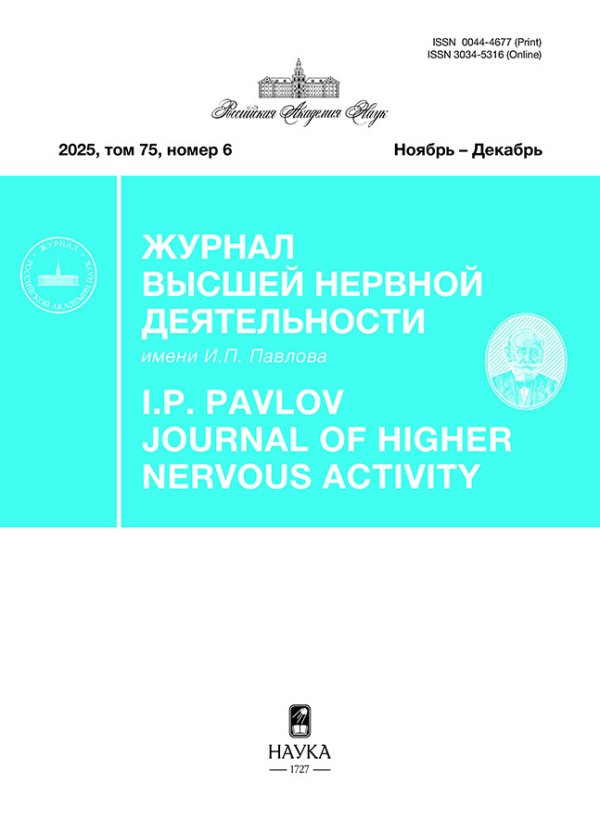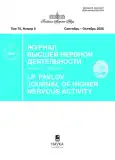The backward conditioned connections in the functional organization of the integrative behavior
- Authors: Balaban P.M.1, Grigoryan G.A.1
-
Affiliations:
- Institute of Higher Nervous Activity and Neurophysiology of RAS
- Issue: Vol 75, No 5 (2025)
- Pages: 515-528
- Section: ОБЗОРЫ И ТЕОРЕТИЧЕСКИЕ СТАТЬИ
- URL: https://rjsvd.com/0044-4677/article/view/692561
- DOI: https://doi.org/10.31857/S0044467725050017
- ID: 692561
Cite item
Abstract
The present paper describes backward conditioned connections (BCC) as a universal principle of brain activity. The first section analyzes the historical view of the problem: the discovery of the phenomenon of BCC, the rules and regularities of its manifestation (the role of the ratio of the strength of the paired stimuli, the duration of the conditioned stimulus, the time following after the unconditioned stimulus before the start of the conditioned stimulus, the number of pairings, and other factors). In the second section, some hypotheses explaining the formation, functioning, and role of bilateral conditioned connections in the process of organizing holistic behavior are considered. And the last section describes the current state of the problem of reverse US-CS connections – the study of 2nd-order conditioned reflexes, sensory preconditioning, stimulus equivalence analysis, and the role of context. The importance of dopamine in BCC and the role of these connections in memory reconsolidation are considered. Attention is paid to modern neurochemical, electrophysiological, optogenetic and other studies of the BCC.
About the authors
P. M. Balaban
Institute of Higher Nervous Activity and Neurophysiology of RAS
Author for correspondence.
Email: pmbalaban@gmail.com
Moscow, Russia
G. A. Grigoryan
Institute of Higher Nervous Activity and Neurophysiology of RAS
Email: grigorygrigoryan@hotmail.com
Moscow, Russia
References
- Анохин П.К. Биология и нейрофизиология условного рефлекса. М.: Медицина, 1968. 547 с.
- Асратян Э.А. Рефлекторная теория высшей нервной деятельности. Избранные труды. М.: Изд-во Наука, 1983. 326 с.
- Асратян Э.А. Двусторонняя связь как общий нейрофизиологический принцип. Журн. высш. нервн. деят. им. И.П. Павлова. 1981. 31 (1): 3–11.
- Асратян Э.А. Очерки по высшей нервной деятельности. Ереван: Изд-во АН Арм. ССР, 1977. 347 с.
- Асратян Э.А. В книге: “Рефлексы головного мозга”. Международная конференция, посвященная 100-летию выхода в свет одноименного труда И.М. Сеченова. М.: Наука, 1965. 648 с.
- Балабан П.М., Максимова О.А., Галанина Г.Н. Клеточные реакции при выработке обратной условной связи у виноградной улитки. Журнал высш. нервн. деят. им. И.П. Павлова. 1985. 35 (3): 497–503.
- Григорьян Г.А. Память и депрессии. Журнал высш. нервн. деят. им. И.П. Павлова. 2006. 56 (4): 556–570.
- Григорьян Г.А. Взаимодействие сигнальных, мотивационных и исполнительных компонентов условного рефлекса. Журнал высш. нервн. деят. им. И.П. Павлова, 1990. 40 (4): 629–642.
- Григорьян Г.А., Граштьян Э., Кароди З., Келлени Л. Вызванные потенциалы при выработке условного рефлекса на стимуляцию гиппокампа у крыс. Журнал высш. нервн. деят. им. И.П. Павлова. 1986. 36 (1): 101–109.
- Максимова О.А., Балабан П.М. Нейронные механизмы пластичности поведения. М.: Наука, 1983.
- Максимова О.А. Формирование двигательной пищедобывательной условной реакции у виноградной улитки. Журнал высш. нервн. деят. им. И.П. Павлова. 1979. 29 (4): 793.
- Павлов И.П. Ответ физиолога психологам. Киев: Госмедиздат УССР, 1953. 56 с.
- Павлыгина Р.А. Доминанта и условный рефлекс на стадии генерализации. Ж. высш. нервн. деят. 1973. 23 (4): 686–697.
- Симонов П.В. Мозг, эмоции, потребности и поведение. Избранные труды. М.: Наука, 2004. Т. 1. 437 с.
- Cимонов П.В. Мотивированный мозг. М.: Наука, 1987. 269 с.
- Симонов П.В. Высшая нервная деятельность человека. М.: Наука, 1975. 173 с.
- Abraham W.C., Bliss T.V.P., Collingridge G.L., Morris R.G.M. Long-term potentiation: 50 years on: past, present and future. Philos. Trans. R. Soc.Lond. B. Biol Sci. 2024. 379 (1906): 20230218. https://doi.org/10.1098/rstb.2023.0218
- Alonso-Alvarez B.A. Review of backward higher-order conditioning: implications for a Pavlovian conditioning analysis of stimulus equivalence. Perspect. Behav. Sci. 2023. 46 (3–4): 493–514. https://doi.org/10.1007/s40614-023-00385
- Asratyan E.A. The two-way connection as a basic principle of neurophysiology. Pavlov J. Biol. Sci. 1981. 16 (1): 1–7. https://doi.org/10.1007/BF03001264
- Asratyan E.A. Some peculiarities of formation, functioning and inhibition of conditioned reflexes with two-way connections. Prog. Brain Res. 1968. (22): 8–20. https://doi.org/10.1016/S0079-6123(08)63491-3
- Ayres J.J.B., Haddad C., Albert M. One-trial excitatory backward conditioning as assessed by conditioned suppression of licking in rats: concurrent observations of lick suppression and defensive behaviors. Animal Learning Behavior. 1987. 15: 212–217.
- Barnet R.C., Miller R.R. Second-order excitation mediated by a backward conditioned inhibitor. Journal of Experimental Psychology: Animal Behavior Processes.1996. 22: 279296.
- Barnet R.C., Arnold H.M., Miller R.R. Simultaneous conditioning demonstrated in second-order conditioning: Evidence for similar associative structure in forward and simultaneous conditioning. Learning and Motivation. 1991. 22: 253–268.
- Beritov I.S. Neural Mechanisms of Higher Vertebrate Behavior. (Translated by W.T. Liberson) Boston. Little Brown. 1965.
- Bliss T. Pursuing synaptic plasticity from cortext on LTP in the hippocampus. Hippocampus. 2025. 35 (1): e23665. https://doi.org/10.1002/hipo.23665
- Champion R.A., Jones J.E. Forward, backward and pseudo conditioning of the GSR. Journal Experimental Psychology. 1961. (62): 58–61.
- Chang R.C., Blaisdell A.P., Miller R.R. Backward conditioning: mediation by the context. Journal of Experimental Psychology: Animal Behavior Processes. 2003. (29): 171–183. https://doi.org/10.1037/0097-7403.29.3.171
- Cole R.P., Barnet R.C., Miller R.R. Temporal encoding in trace conditioning. Animal Learning and Behavior. 1995. 23 (2): 144–153. https://doi.org/10.3758/BF03199929
- Cole R.P., Miller. R.R. Conditioned excitation and conditioned inhibition acquired through backward conditioning. Learning and Motivation. 1999. 30: 129–156.
- Ebbinghaus H. (1885). Überdas Gedächtnis. Untersuchungenzurexp erimentellen Psychologie, Leipzig, Duncker & Humblot. Цитировано по переводу на англ. язык: Ebbinghaus H. Memory: a contribution to experimental psychology. Translated by Henry A. Ruger & Clara E. Bussenius (1913). New York, Columbia University.
- Gormezano I., Tait R.W. The Pavlovian analysis of instrumental conditioning. Pavlov J. Biol. Sci. 1976. 11 (1): 37–55. https://doi.org/10.1007/BF03000536
- Gormezano I., Moore J.W. Classical conditioning. In M.H. Marx (Ed.). Learning: Processes. New York. MacMillan. 1969.
- Gormezano I. Classical conditioning. In J.B. Sidowski (Ed.). Experimental Methods and Instrumentation in Psychology. New York: McGraw-Hill. 1966.
- Grigoryan G.A. The systemic effects of the enriched environment on the conditioned fear reaction. Frontiers in Behavioral Neuroscience. 2023. Review article. Front. Behav. Neurosci. 2023 (17): 1227575. https://doi.org/10.3389/fnbeh.2023.1227575
- Hawkins R.D., Carew T.J., Kandel E.R. Effects of interstimulus interval and contingency on classical conditioning of the Aplysia siphon withdrawal reflex. J. Neurosci. 1986. 6 (6): 1695–1701. https://doi.org/10.1523/JNEUROSCI.06-06-01695.1986
- Heth D.C. Simultaneous and backward fear conditioning as a function of number of CSUCS pairings. Journal of Experimental Psychology: Animal Behavior Processes. 1976. 2: 117–129.
- Kendig M.D., Bradfield L.A. Association learning: dopamine and the formation of backward associations. Curr. Biol. 2022. 32 (14): 769–771. https://doi.org/10.1016/j.cub.2022.06.007
- Mackintosh N.J. The psychology of animal learning. Academic Press, 1974.
- Moscovitch A., LoLordo V.M. Role of safety in the Pavlovian backward fear conditioning procedure. Journal of Comparative and Physiological Psychology, 1968. 66 (3, Pt.1): 673–678. https://doi.org/10.1037/h0026548
- Navarro V.M., Wasserman E.A. Bidirectional conditioning: Revisiting Asratyan’s ‘alternating’ training technique. Neurobiol. Learn. Mem. 2020. 171: 107211. https://doi.org/10.1016/j.nlm.2020.107211
- Nikitin E.S., Vavoulis D.V., Kemenes I., Marra V., Pirger Z., Michel M. et al. Persistent sodium current is a non synaptic substrate for long-term associative memory. Curr. Biol. 2008. 18 (16): 1221–1226. https://doi.org/10.1016/j.cub.2008.07.030
- Pavlov I.P. The reply of a physiologist to psychologists. Psychol. Rev. 1932. 89: 91–127.
- Prével A., Krebs R.M. Higher-order conditioning with simultaneous and backward conditioned stimulus: implications for models of pavlovian conditioning. Front. Behav. Neurosci. 2021. 15: 749517. https://doi.org/10.3389/fnbeh.2021.749517
- Prével A., Rivière V., Darcheville J.C., Urcelay G.P., Miller R.R. Excitatory second-order conditioning using a backward first-order conditioned stimulus: A challenge for prediction error reduction. Q. J. Exp. Psychol. (Hove). 2019. 72 (6): 1453–1465. https://doi.org/10.1177/1747021818793376
- Razran G. Mind in evolution: An east-west synthesis of learned behavior and cognition. New York: Houghton Mifflin, 1971.
- Razran G. Backward conditioning. Psychol. Bull. 1956. 53 (1): 55–69. https://doi.org/10.1037/h0044122
- Rescorla R.A., Wagner A.R. A theory of Pavlovian conditioning: Variations in the effectiveness of reinforcement and nonreinforcement. in A. H. B. W.F. Prokasy (Ed.), Classical conditioning: II. Current research and theory. New York: Appleton-Century-Crofts, 1972: 64–99.
- Ressler R.L., Goode T.D., Kim S., Ramanathan K.R., Maren S. Covert capture and attenuation of a hippocampus-dependent fear memory. Nat. Neurosci. 2021. 24 (5): 677–684. https://doi.org/10.1038/s41593-021-00825-5
- Romaniuk C.B., Williams D.A. Conditioning across the duration of a backward conditioned stimulus. J. Exp. Psychol. Anim. Behav. Process. 2000. 26 (4): 454–461. https://doi.org/10.1037//0097-7403.26.4.454
- Schultz W. Dopamine reward prediction-error signaling: a two-component response. Nat. Rev. Neurosci. 2016 (17): 183–195. https://doi.org/10.1038/nrn.2015.26
- Schultz W., Dayan P., Montague P.R. A neural substrate of prediction and reward. Science. 1997 (275): 1593–1599. https://doi.org/10.1126/science.275.5306.1593
- Seitz B.M., Hoang I.B., DiFazio L.E., Blaisdell A.P., Sharpe M. Dopamine errors drive excitatory and inhibitory components of backward conditioning in an outcome-specific manner. J. Curr. Biol. 2022. 32 (14): 3210– 3218.e3. https://doi.org/10.1016/j.cub.2022.06.035
- Smith M.C., Coleman S.R., Gormezano I. Classical conditioning of the rabbit’s nictating membrane response at backward simultaneous and forward CS-UCS intervals. J. Comp. Phisiol. Psychol. 1969. 69: 226–231. https://doi.org/10.1037/h0028212
- Spetch M.L., Wilkie D.M., Pinel J.P. Backward conditioning: A reevaluation of the empirical evidence. Psychological Bulletin. 1981. 89 (1): 163–175. https://doi.org/10.1037/0033-2909.89.1.163
- Trask J., MacCallum P.E., Rideout H., Preisser E.L., Blundell J. Rapamycin attenuates reconsolidation of a backwards-conditioned aversive stimuli in female mice. J. Psychopharm. (Berl). 2024. 241 (3): 601–612. https://doi.org/10.1007/s00213-024-06544-6
- Williams D.A., Hurlburt J.L. Mechanisms of second-order conditioning with a backward conditioned stimulus. J. Exp. Psychol. Anim. Behav. Process. 2000. 26 (3): 340–351. https://doi.org/10.1037//0097-7403.26.3.340
- Ward-Robinson J., Hall G. Backward sensory preconditioning when reinforcement is delayed. Quarterly Journal of Experimental Psychology. Comparative and Physiological Psychology. 1998. 51B (4): 349–362. https://doi.org/10.1080/713932687
Supplementary files











